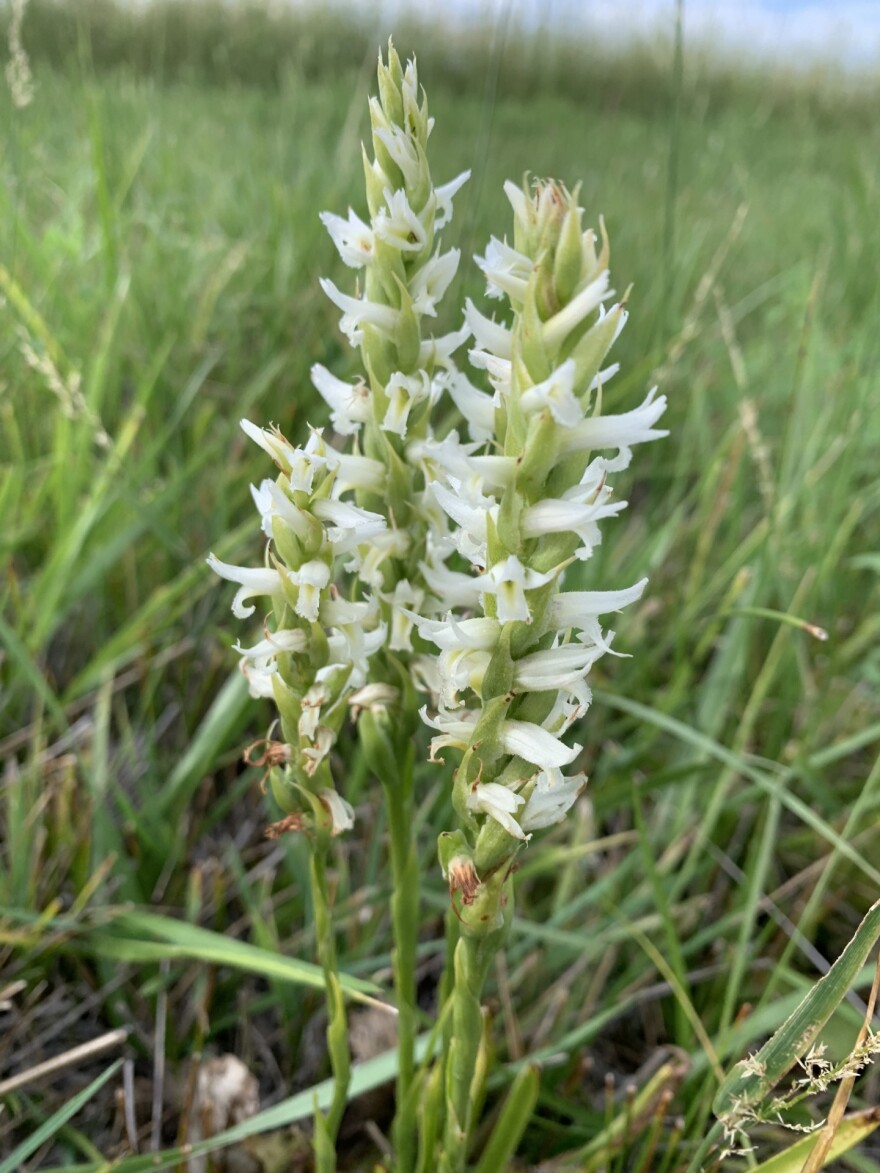It’s a warm summer evening on the west side of Cache Valley, where a small group of volunteers has gathered beside a green pasture. We hear the rattling bugle calls of sandhill cranes in the distance. A Swainson’s hawk scolds us as it circles overhead. As we walk into the field, our steps disturb dragonflies and leopard frogs. But we’re not here for the wildlife. We’re after something rarer: orchids!
Wait, what? Orchids? You mean those delicate tropical plants with colorful blossoms that city folks grow in humid greenhouses? Well, yes actually. It turns out that orchids grow on almost every type of land surface across the globe, including some in Utah.
The orchid we’re seeking has drawn the attention of the federal government. You see, while the orchid family has nearly 28,000 species worldwide, many of those are rare. The one we’re looking for, called Ute Ladies’-tresses, is on the federal Threatened Species list, which gives it legal protection from human impacts until it’s no longer at risk of disappearing.
In Cache County, Ute Ladies’-tresses are guarded by the Bear River Land Conservancy, a nonprofit whose mission is to protect open space and working farms and ranches in northern Utah. After orchids were found in a pasture near the small town of Mendon, the Conservancy received funding to purchase and manage the land in ways that could help the orchids to thrive, and to provide data to the U.S. Fish and Wildlife Service about how the population is doing.

That’s why we volunteers are gathered in a pasture on a Friday evening. Our job is to carefully walk the property, looking for blossoms. When one of us sees an orchid in bloom, we mark the spot with a bamboo plant stake. Then someone trails along behind them – usually that’s me – and records the location using a global positioning system. By taking these GPS measurements, we not only count how many plants have flowered that year, but we also map their locations to learn where we might be losing or gaining orchids over time.
Ute Ladies’-tresses has narrow leaves, hard to distinguish from the surrounding grasses and sedges and rushes. But then it sends up 1-5 flower stalks, up to a foot high. Each stalk has numerous small white flowers arranged in a graceful spiral. The plant likes to grow on solid ground that floods at some point in the year – a streambed that’s dry except during spring runoff, or a flood-irrigated pasture like the one in Mendon. At our site, the first flowers emerge around Pioneer Day, and new ones continue to appear till about Labor Day.
Monitoring this population since 2013, we’ve learned a lot about Ute Ladies’-tresses. One key finding is that flower numbers fluctuate widely from year to year. Our highest count was nearly 2,000 flowering specimens in 2017. But in the very dry summer of 2021, we counted fewer than 30. That year was scary if you’re trying to protect a rare plant, But these orchids live for several years, flowering only when conditions are right, and last year we found more than 1,400.
You see, even if a plant is rare, that doesn’t have to mean it’s fragile. Some rare plants are, to be sure, but Ute Ladies’-tresses is resilient. In fact, last fall the Fish and Wildlife Service proposed removing the species from the Threatened list. One reason they feel they can do so is the continued protection it gets from groups like Bear River Land Conservancy. And so I look forward to many more August evenings in a Mendon meadow, sharing time with this lovely orchid.
I’m Mark Brunson, and I’m wild about Utah’s rare plants.
Credits:
Images Courtesy & Copyright Mark Brunson, Photographer
Featured Audio: Courtesy & © Kevin Colver, https://wildstore.wildsanctuary.com/collections/special-collections and J. Chase and K.W. Baldwin. https://upr.org/
Text: Mark Brunson,
Additional Reading: Lyle Bingham, https://bridgerlandaudubon.org/
Additional Reading
Wild About Utah pieces authored by Mark Brunson
Ute Ladies’ Tresses in Wet Pasture, Bear River Land Conservancy, https://www.bearriverlandconservancy.org/mendon-meadows
Ute Ladies’ Tresses, Utah Species, Fieldguide, Utah Division of Wildlife Resources, State of Utah, https://fieldguide.wildlife.utah.gov/?species=spiranthes%20diluvialis
Species Profile for Ute ladies’-tresses (Spiranthes diluvialis), US Fish & Wildlife Service, https://ecos.fws.gov/ecp/species/2159
Delmatier, Charmaine, Ute Lady’s Tresses (Spiranthes diluvialis), Plant of the Week, USDA Forest Service, 2016, US Department of Agriculture(USDA), https://www.fs.usda.gov/wildflowers/plant-of-the-week/spiranthes_diluvialis.shtml
St. John, Loren, Ogle, Dan, USDA NRCS, Ute Lady’s Tresses Spiranthes diluvialis Sheviak, Natural Resources Conservation Service, US Department of Agriculture(USDA), https://plants.usda.gov/DocumentLibrary/plantguide/pdf/pg_spdi6.pdf



